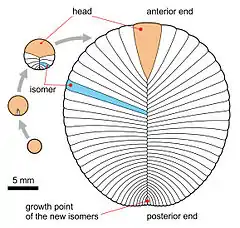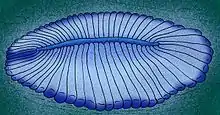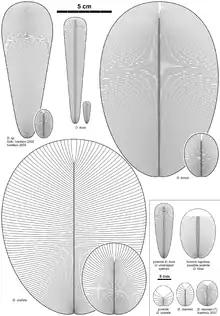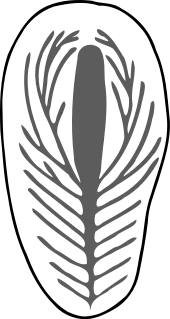Dickinsonia
Dickinsonia is an extinct genus of basal animal that lived during the late Ediacaran period in what is now Australia, Russia and Ukraine. The individual Dickinsonia typically resembles a bilaterally symmetrical ribbed oval. Its affinities are presently unknown; its mode of growth is consistent with a stem-group bilaterian affinity,[3] though some have suggested that it belongs to the fungi, or even an "extinct kingdom".[4][5][6] The discovery of cholesterol molecules in fossils of Dickinsonia lends support to the idea that Dickinsonia was an animal.[7]
| Dickinsonia | |
|---|---|
 | |
| Cast of Dickinsonia costata from Australia | |
| Scientific classification | |
| Kingdom: | Animalia |
| Phylum: | †Proarticulata |
| Class: | †Dipleurozoa |
| Family: | †Dickinsoniidae |
| Genus: | †Dickinsonia Sprigg, 1947 |
| Type species | |
| †Dickinsonia costata Sprigg, 1947 | |
| Species | |
| |
| Synonyms | |
|
Species Synonymy
| |
Description

Dickinsonia fossils are known only in the form of imprints and casts in sandstone beds. The specimens found range from a few millimetres to about 1.4 metres (4 ft 7 in) in length, and from a fraction of a millimetre to a few millimetres thick.[8]
They are nearly bilaterally symmetric, segmented, round or oval in outline, slightly expanded to one end (i.e. egg-shaped outline). The rib-like segments are radially inclined towards the wide and narrow ends, and the width and length of the segments increases towards the wide end of the fossil. The segments are separated by a thin ridge or groove along the axis of symmetry into right and left halves. The segments are organized in an alternating pattern according to glide reflection symmetry rather than bilateral symmetry;[2][9] thus, these "segments" are isomers.[2][10] This glide reflection is also found in Spriggina, Yorgia, Andiva, Cephalonega and other relatives of a Dickinsonia from the extinct Phylum Proarticulata.[11]
The segments of Dickinsonia have been described by Adolf Seilacher as self-organising "pneu structures", chambers filled with a liquid at higher than ambient pressure, analogous to a quilted air mattress.[12][13]
Some spectacular fossils attributed to Dickinsonia appear to preserve internal anatomy, believed to represent a tract that both digested food and distributed it throughout the organism.[14]
Discovery and naming

The first species and specimens of this fossil organism was first discovered in the Ediacara Member of the Rawnsley Quartzite, Flinders Ranges in South Australia. Additional specimens of Dickinsonia are also known from the Mogilev Formation in the Dniester River Basin of Podolia, Ukraine[15] and from the Lyamtsa, Verkhovka, Zimnegory and Yorga Formations in the White Sea area of the Arkhangelsk Region, Chernokamen Fm. of the Central Urals, Russia,[8] These deposits have been dated to 567–550 Myr.[16][17][18], and the Dengying Formation in the Yangtze Gorges area, South China (ca. 551–543 Ma)[19]
Reg Sprigg, the original discoverer of the Ediacaran biota in Australia,[20] described Dickinsonia, naming it after Ben Dickinson, then Director of Mines for South Australia, and head of the government department that employed Sprigg.
Body fossils
As a rule, Dickinsonia fossils are preserved as negative impressions on the bases of sandstone beds. Such fossils are imprints of the upper sides of the benthic organisms that have been buried under the sand.[21][22] The imprints formed as a result of cementation of the sand before complete decomposition of the body. The mechanism of cementation is not quite clear; among many possibilities, the process could have arisen from conditions which gave rise to pyrite "death masks"[22] on the decaying body, or perhaps it was due to the carbonate cementation of the sand.[23] The imprints of the bodies of organisms are often strongly compressed, distorted, and sometimes partly extend into the overlying rock. These deformations appear to show attempts by the organisms to escape from the falling sediment.[10][24][25]
Rarely, Dickinsonia have been preserved as a cast in massive sandstone lenses, where it occurs together with Pteridinium, Rangea and some others.[16][26][27][28] These specimens are products of events where organisms were first stripped from the sea-floor, transported and deposited within sand flow.[16][28] In such cases, stretched and ripped Dickinsonia occur. The first such specimen was described as a separate genus and species, Chondroplon bilobatum[29] and later redefined as Dickinsonia.[1]
Trace fossils
Several trace fossils, including Epibaion and Phyllozoon, have been interpreted as feeding impressions of Dickinsonia and its relatives. Such fossils consist of large, rounded impressions with less relief that the usual upper side of these animals.[10][24][30]
Species

Since 1947, a total of nine species have been described:
| Species | Authority | Location | Status | Synonyms | Notes |
|---|---|---|---|---|---|
| Dickinsonia brachina [31] | Wade, 1972 | Australia | Synonym of Dickinsonia tenuis | ||
| Dickinsonia costata [20] | Sprigg, 1947 | Australia, Russia and Ukraine | Valid | Dickinsonia elongata Dickinsonia minima Dickinsonia spriggi Papilionata eyrei | Unlike other species, D. costata has comparatively fewer, wider segments/isomers. |
| Dickinsonia elongata [32] | Glaessner & Wade, 1966 | Australia | Synonym of Dickinsonia costata | ||
| Dickinsonia lissa [31] | Wade, 1972 | Australia | Valid | D. lissa is extremely elongated (up to 15 cm), almost ribbon-like in shape, with numerous thin isomers. The isomers of the head area are short in comparison with those of the rest of the body. The fossil bears a distinct axial ledge consisting of two parallel bands extending from the head region to the posterior end of the body. | |
| Dickinsonia menneri [26] | Keller, 1976 | Russia | Valid | Vendomia menneri | D. menneri is a small organism up to 8 mm in length, and strongly resembles juvenile specimens of D. costata with its small number of isomers and well-marked head. D. menneri differs from juvenile D. costata by its slightly more elongated form.
Originally classified as Vendomia, it was redefined as Dickinsonia by Ivantsov, 2007[2] |
| Dickinsonia minima [33] | Sprigg, 1949 | Australia | Synonym of Dickinsonia costata | ||
| Dickinsonia rex [34] | Jenkins, 1992 | Australia | Valid | D. rex was erected for selected paratypes of D. elongata. This species is represented by only several very big specimens (up to more than 1 m in length), and does not have a distinct determination. A large size is the major reason for D. rex's species status. Individuals identified as D. rex may simply be large specimens of D. costata and or D. tenuis. | |
| Dickinsonia spriggi [35] | Harrington & Moore, 1955 | Australia | Synonym of Dickinsonia costata | ||
| Dickinsonia tenuis [32] | Glaessner & Wade, 1966 | Australia and Russia | Valid | Dickinsonia brachina | Strongly resembles D. costata, but differs from it by more narrow and numerous segments, sparingly lengthened oval form of the body. |
Classification

The affinities of Dickinsonia are uncertain. It has been variously interpreted as a jellyfish, coral, polychaete worm, turbellarian, mushroom, xenophyophoran protist, sea anemone, lichen,[36][37] and even a close ancestor of the chordates.[38] Genera such as Yorgia and Marywadea somewhat resemble Dickinsonia, and may be related. However, it is possible that Dickinsonia falls into a group of organisms that became extinct before the Cambrian. Its construction is loosely similar to other Ediacaran organisms, and the similarity of their architecture suggests that dickinsoniamorphs may belong in a clade with Charnia and other rangeomorphs.[39] Paleontologist Adolph Seilacher even went so far as to suggest that most of the Ediacaran fauna represents a separate Kingdom termed "Vendozoa" (now: "Vendobionta") that thrived just before most of the modern multicellular animal phyla appeared in the fossil record.[5]
There is an argument that Dickinsonia is more derived than a sponge, but less so than a eumetazoan. The idea that these organisms could move depends on whether Epibaion is its trace fossil or just a different preservation state.[40] It lacks any convincing evidence for a mouth, anus or gut, and appears to have fed by absorption on its bottom surface, much like modern placozoans do. The placozoans are simple animals which feed with their soles and are phylogenetically between sponges and eumetazoa; this suggests that Dickinsonia may have been a stem-group placozoan, or somewhere more crownwards than sponges on the eumetazoan stem. [41][42] A study of inferred growth patterns determined that Dickinsonia is a Eumetazoan but a more accurate affiliation was not established.[43] In a subsequent study Hoyal Cuthill & Han (2018) assigned Dickinsonia to the extinct animal group Petalonamae (placed as sister group to the Eumetazoa), which also included the genera Stromatoveris, Arborea and Pambikalbae, as well as rangeomorphs and erniettomorphs.[44]
See also
References
- Hofmann, Hans J. (1988). "An alternative interpretation of the Ediacaran (Precambrian) chondrophore Chondroplon Wade". Alcheringa. 12 (4): 315–318. doi:10.1080/03115518808619130.
- Ivantsov, A. Yu (2007). "Small Vendian transversely Articulated fossils". Paleontological Journal. 41 (2): 113–122. doi:10.1134/S0031030107020013. S2CID 86636748.
- Gold, D. A.; Runnegar, B.; Gehling, J. G.; Jacobs, D. K. (2015). "Ancestral state reconstruction of ontogeny supports a bilaterian affinity for Dickinsonia". Evolution & Development. 17 (6): 315–397. doi:10.1111/ede.12168. PMID 26492825. S2CID 26099557.
- Pflug (1973). "Zur fauna der Nama-Schichten in Südwest-Afrika. IV. Mikroscopische anatomie der petalo-organisme". Palaeontographica (B144): 166–202.
- Seilacher, Adolf (1992). "Vendobionta and Psammocorallia: lost constructions of Precambrian evolution". Journal of the Geological Society, London. 149 (4): 607–613. Bibcode:1992JGSoc.149..607S. doi:10.1144/gsjgs.149.4.0607. S2CID 128681462. Retrieved 2007-06-21.
- McMenamin M. (1998). The Garden of Ediacara. New York: Columbia University Press. ISBN 978-0-231-10559-0. OCLC 228271905. It lived during the late Ediacaran (part of Precambrian). Dinosaurs a visual encyclopedia. New York: DK Publishing, Inc. 2018-04-03. ISBN 9781465469489.
- Bobrovskiy, Ilya; Hope, Janet M.; Ivantsov, Andrey; Nettersheim, Benjamin J.; Hallmann, Christian; Brocks, Jochen J. (20 September 2018). "Ancient steroids establish the Ediacaran fossil Dickinsonia as one of the earliest animals". Science. 361 (6408): 1246–1249. Bibcode:2018Sci...361.1246B. doi:10.1126/science.aat7228. PMID 30237355.
- Fedonkin M. A.; Gehling J. G.; Grey K.; Narbonne G. M.; Vickers-Rich P. (2007). The Rise of Animals. Evolution and Diversification of the Kingdom Animalia. Johns Hopkins University Press. p. 326. ISBN 978-0-8018-8679-9.
- Ivantsov, A. Yu (2012). "Becoming metamery and bilateral symmetry in Metazoa: way of Proarticulata". Morphogenesis in the Individual and Historical Development: Symmetry and Asymmetry.: 16–17.
- Ivantsov, A. Y. (2011). "Feeding traces of Proarticulata — the Vendian metazoa". Paleontological Journal. 45 (3): 237–248. doi:10.1134/S0031030111030063. S2CID 128741869.
- A.Y. Ivantsov; M.A. Fedonkin; A.L. Nagovitsyn; M.A. Zakrevskaya (2019). "Cephalonega, a new generic name, and the system of Vendian Proarticulata". Paleontological Journal. 53 (5): 447–454. doi:10.1134/S0031030119050046. S2CID 203853224.
- Seilacher, Adolf (1991). "Self-Organizing Mechanisms in Morphogenesis and Evolution". In Schmidt-Kittler, Norbert; Vogel, Klaus (eds.). Constructional Morphology and Evolution. Springer. pp. 251–271. doi:10.1007/978-3-642-76156-0_17. ISBN 978-3-642-76158-4.
- Seilacher, Adolf (July 1989). "Vendozoa: Organismic construction in the Proterozoic biosphere". Lethaia. 22 (3): 229–239. doi:10.1111/j.1502-3931.1989.tb01332.x.
- Ivantsov, A. Y. (2004). "New Proarticulata from the Vendian of the Arkhangel'sk Region" (PDF). Paleontological Journal. 38 (3): 247–253. Archived from the original (PDF) on 2007-09-27. Retrieved 2007-09-27.
- Fedonkin, M. A. (1983). "Non-skeletal fauna of Podoloia, Dniester River valley". In Velikanov, V. A.; Assejeva, E. A.; Fedonkin, M. A. (eds.). The Vendian of the Ukraine (in Russian). Kiev: Naukova Dumka. pp. 128–139.
- Grazhdankin, Dima (2004). "Patterns of distribution in the Ediacaran biotas: facies versus biogeography and evolution" (PDF). Paleobiology. 30 (2): 203–221. doi:10.1666/0094-8373(2004)030<0203:PODITE>2.0.CO;2.
- Maslov A.V., Podkovyrov V.N., Grazhdankin D.V., Kolesnikov A.V. (2018). "Upper Vendian in the east, northeast and north of East European Platform: Depositional processes and biotic evolution". Litosfera. 18 (4): 520–542. doi:10.24930/1681-9004-2018-18-4-520-542.CS1 maint: multiple names: authors list (link)
- Kolesnikov A.V., Liu A.G., Danelian T., Grazhdankin D.V. (2018). "A reassessment of the problematic Ediacaran genus Orbisiana Sokolov 1976". Precambrian Research. 316: 197–205. Bibcode:2018PreR..316..197K. doi:10.1016/j.precamres.2018.08.011.CS1 maint: multiple names: authors list (link)
- Wang, Xiao-Peng; Chen, Zhe; Pang, Ke; Zhou, Chuan-Ming; Xiao, Shuhai; Wan, Bin; Yuan, Xun-Lai (2021). "Dickinsonia from the Ediacaran Dengying Formation in the Yangtze Gorges area, South China". Palaeoworld. doi:10.1016/j.palwor.2021.01.002.
- Sprigg, Reg C. (1947). "Early Cambrian (?) Jellyfishes from the Flinders Ranges, South Australia" (PDF). Trans. Roy. Soc. S. Aust. 71: 212–24. Archived from the original (PDF) on 2007-09-29.
- Ivantsov, A. Y. (2009). "A New Reconstruction of Kimberella, a Problematic Vendian Metazoan". Paleontological Journal. 43 (6): 601–611. doi:10.1134/S003103010906001X. S2CID 85676210.
- Gehling, J.G. (1999). "Microbial mats in terminal Proterozoic siliciclastics; Ediacaran death masks". PALAIOS. 14 (1): 40–57. Bibcode:1999Palai..14...40G. doi:10.2307/3515360. JSTOR 3515360.
- Serezhnikova, E.A. (2011). "Microbial Binding as a Probable Cause of Taphonomic Variability of Vendian Fossils: Carbonate Casting?". Advances in Stromatolite Geobiology. Lecture Notes in Earth Sciences. 131. pp. 525–535. doi:10.1007/978-3-642-10415-2_31. ISBN 978-3-642-10414-5.
- Ivantsov, A.Yu. (2013). "Trace Fossils of Precambrian Metazoans "Vendobionta" and "Mollusks"". Stratigraphy and Geological Correlation. 21 (3): 252–264. Bibcode:2013SGC....21..252I. doi:10.1134/S0869593813030039. S2CID 128638405.
- Runnegar, Bruce (1982). "Oxygen requirements, biology and phylogenetic significance of the late Precambrian worm Dickinsonia, and the evolution of the burrowing habit". Alcheringa: An Australasian Journal of Palaeontology. 6 (3): 223–239. doi:10.1080/03115518208565415.
- B. M. Keller; M. A. Fedonkin (1976). "New Records of Fossils in the Valdaian Group of the Precambrian on the Syuz'ma River" (PDF). Izv. Akad. Nauk SSSR, Ser. Geol. (in Russian). 3: 38–44. Archived from the original (PDF) on 2007-09-27.
- Keller, B. M.; Fedonkin, M. A. (1977). "New organic fossil finds in the Precambrian Valday series along the Syuz'ma River". International Geology Review. 19 (8): 924–930. Bibcode:1977IGRv...19..924K. doi:10.1080/00206817709471091.
- Gehling, J.G.; Droser, M.L. (2013). "How well do fossil assemblages of the Ediacara Biota tell time?". Geology. 41 (4): 447–450. Bibcode:2013Geo....41..447G. doi:10.1130/G33881.1.
- Wade, M. (1971). "Bilateral Precambrian Chondrophores from the Ediacara Fauna, South Australia". Proceedings of the Royal Society of Victoria. 84 (1): 183–188.
- Ivantsov, A.Y.; Malakhovskaya, Y.E. (2002). "Giant Traces of Vendian Animals" (PDF). Doklady Earth Sciences. 385 (6): 618–622. Archived from the original (PDF) on 2007-07-04. Retrieved 2008-02-24.
- Wade, M. (1972). "Dickinsonia: Polychaete Worms from the Late Precambrian Ediacara Fauna, South Australia". Mem. Queensl. Mus. 16 (2): 171–190.
- Glaessner, M.F.; Wade, M. (1966). "The late Precambrian fossils from Ediacara, South Australia" (PDF). Palaeontology. 9 (4): 599.
- Sprigg, R.C. (1949). "Early Cambrian "Jellyfishes" of Ediacara, South Australia and Mount John, Kimberley District, Western Australia" (PDF). Transactions of the Royal Society of South Australia. 73: 72–99.
- Jenkins, R. J. F. (1992). "Functional and ecological aspects of Ediacarian assemblages". In Lipps, J.; Signor, P. W. (eds.). Origin and early evolution of the Metazoa. New York: Springer. pp. 131–176. ISBN 978-0-306-44067-0. OCLC 231467647.
- Harrington, N. J.; Moore. R. C. (1955). "Kansas Pennsylvanian and other jellyfishes". Bull. Kansas Geol. Surv. 114 (5): 153–163.
- Retallack, G.J. (2007). "Growth, decay and burial compaction of Dickinsonia, an iconic Ediacaran fossil" (PDF). Alcheringa: An Australasian Journal of Palaeontology. 31 (3): 215–240. doi:10.1080/03115510701484705. S2CID 17181699.
- Retallack, Gregory J. (2004) "Death, Decay and Destruction of Dickinsonia". Geological Society of America Abstracts with Programs, Vol. 36, No. 5, p. 521 Archived 2016-03-06 at the Wayback Machine
- Dzik, Jerzy. (2000) "The Origin of the Mineral Skeleton in Chordates." in Max Knobler Hecht, Ross J. MacIntyre and Michael T. Clegg, eds. Evolutionary Biology Vol. 31. Pp. 105-46. Springer. ISBN 0-306-46178-1 – URL retrieved February 10, 2007
- Brasier, M.; Antcliffe, J. (2 August 2004). "Decoding the Ediacaran Enigma". Science. 305 (5687): 1115–1117. doi:10.1126/science.1102673. PMID 15326344. S2CID 128702365.
- Retallack, G.J. (2016). "Ediacaran sedimentology and paleoecology of Newfoundland reconsidere". Sedimentary Geology. 333: 15–31. Bibcode:2016SedG..333...15R. doi:10.1016/j.sedgeo.2015.12.001.
- Sperling, Erik; Vinther, Jakob; Pisani, Davide; Peterson, Kevin (2008). "A placozoan affinity for Dickinsonia and the evolution of Late Precambrian metazoan feeding modes" (PDF). In Cusack, M; Owen, A; Clark, N (eds.). Programme with Abstracts. Palaeontological Association Annual Meeting. 52. Glasgow, UK. p. 81.
- Sperling, Erik; et al. (2008). "A Placozoan Affinity for Dickinsonia and the Evolution of Late Precambrian Metazoan Feeding Modes". Geological Society of America Abstracts with Programs. 40 (6): 508. Archived from the original on 2018-02-28. Retrieved 2008-10-27.
- Hoekzema, Renee S.; Brasier, Martin D.; Dunn, Frances S.; Liu, Alexander G. (2017-09-13). "Quantitative study of developmental biology confirms Dickinsonia as a metazoan". Proc. R. Soc. B. 284 (1862): 20171348. doi:10.1098/rspb.2017.1348. PMC 5597836. PMID 28904140.
- Cuthill, Jennifer F. Hoyal; Han, Jian (2018). "Cambrian petalonamid Stromatoveris phylogenetically links Ediacaran biota to later animals" (PDF). Palaeontology (Submitted manuscript). 61 (6): 813–823. doi:10.1111/pala.12393.